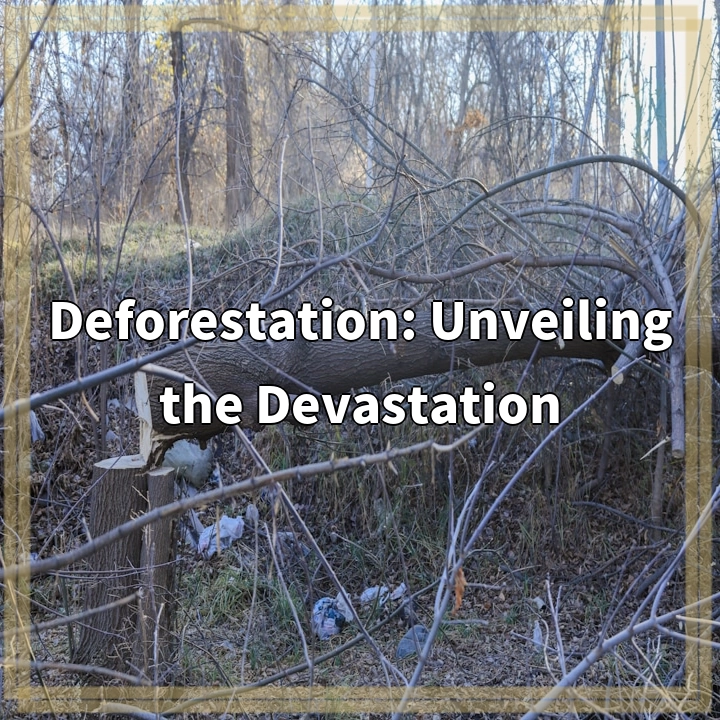
What is Deforestation?
Deforestation refers to the deliberate and widespread removal of trees from forests, leading to the conversion of forest areas into non-forest lands. This process involves clear-cutting or logging forests for various purposes, such as agriculture, urbanization, logging, and mining. It is a significant environmental issue that has far-reaching consequences for ecosystems, climate, and communities around the world.
Real-World Problems Associated with Deforestation
Loss of Biodiversity
One of the major concerns with deforestation is the loss of biodiversity. Forests are home to millions of species of plants, animals, and insects, many of which are unique and play critical roles within their ecosystems. As trees are cut down, the habitats of these creatures are destroyed, leading to a decline in populations and in some cases, extinction. This loss of biodiversity disrupts the delicate balance of ecosystems and can have cascading effects on other species and the environment as a whole.
Climate Change
Forests act as crucial carbon sinks, absorbing and storing large amounts of carbon dioxide (CO2) from the atmosphere. When trees are cleared, not only is this carbon storage capacity reduced, but the carbon stored in the biomass is released back into the atmosphere as CO2 through burning or decomposition. This contributes to the greenhouse effect and exacerbates climate change. Deforestation is responsible for a significant portion of global greenhouse gas emissions, making it a primary driver of climate change.
Livelihood Disruption
Many communities around the world rely on forests for their livelihoods. Indigenous peoples, in particular, have deep connections with forest ecosystems and depend on them for food, medicine, shelter, and cultural practices. Deforestation often leads to the displacement of communities and the loss of their traditional ways of life. It can result in the loss of income and resources, creating socio-economic challenges for affected communities.
Soil Erosion and Environmental Degradation
Trees play a crucial role in maintaining soil stability. Their roots help bind the soil together, preventing erosion caused by wind and water. When forests are cleared, the exposed soil is vulnerable to erosion, leading to increased sedimentation in water bodies, reduced soil fertility, and land degradation. Deforestation also disrupts natural water cycles, leading to changes in local hydrological patterns and a higher risk of flooding, especially in areas with steep slopes.
Loss of Cultural and Traditional Knowledge
Indigenous peoples and local communities have valuable traditional knowledge and practices that have been developed and refined over generations. This knowledge often includes sustainable forest management techniques, medicinal plant uses, and conservation methods. Deforestation threatens the preservation and transmission of these cultural practices, eroding valuable knowledge systems that have the potential to contribute to sustainable development and environmental stewardship.
Economic Impacts
While deforestation may bring short-term economic benefits, such as timber extraction or expansion of agricultural land, the long-term economic impacts can be devastating. Forests provide essential ecosystem services, such as water purification, soil protection, and climate regulation, which are often undervalued or overlooked. The destruction of these services can have significant economic consequences, including reduced agricultural productivity, increased healthcare costs, and decreased resilience to natural disasters.
Conclusion
Deforestation is a critical environmental issue with far-reaching consequences. It not only leads to the loss of biodiversity and disruption of ecosystems but also contributes to climate change, impacts livelihoods, causes soil erosion, erodes cultural knowledge, and has long-term economic implications. Addressing deforestation requires a multifaceted approach, involving sustainable land use practices, forest conservation efforts, policy interventions, and international cooperation. It is necessary to recognize the urgency of this problem and take collective action to protect and restore our forests for the well-being of present and future generations.

Potential Solutions
Addressing deforestation requires a range of approaches and collaborative efforts at various levels. Here are some potential solutions to combat deforestation and its associated problems:
1. Implement Sustainable Land Use Practices
Promote and implement sustainable land management practices, such as agroforestry and responsible logging techniques, that minimize the negative impacts on forests and biodiversity. Encourage farmers and landowners to adopt sustainable agriculture methods that prioritize conservation and protect forested areas.
2. Strengthen Forest Conservation Efforts
Increase efforts to protect and conserve existing forests through the establishment and management of protected areas, national parks, and wildlife reserves. Enhance monitoring and enforcement measures to prevent illegal logging, encroachment, and land conversion.
3. Develop and Enforce Effective Policies
Enact and enforce policies and regulations that promote sustainable forest management and address the drivers of deforestation, such as unsustainable agricultural practices, infrastructure development, and trade in illegal timber. Encourage the integration of environmental considerations into land-use planning and decision-making processes.
4. Support Local and Indigenous Communities
Recognize and respect the rights of local and indigenous communities who have sustainable traditional practices and knowledge of forest management. Involve them in decision-making processes, empower them with land tenure rights, and support community-led forest conservation initiatives.
5. Promote Reforestation and Afforestation
Invest in reforestation and afforestation projects to restore degraded areas and establish new forests. Support initiatives that involve local communities, employ native tree species, and focus on ecosystem restoration to enhance biodiversity and carbon sequestration.
6. Raise Awareness and Advocate
Educate and raise awareness among the public, policymakers, and businesses about the social, ecological, and economic value of forests. Advocate for sustainable practices, responsible consumption, and the integration of forest conservation into climate change mitigation and adaptation strategies.
Conclusion
Addressing deforestation requires a multifaceted and collaborative approach. By implementing sustainable land use practices, strengthening forest conservation efforts, developing effective policies, supporting local communities, promoting reforestation, and raising awareness, we can work towards mitigating the devastating effects of deforestation and protecting our invaluable forest ecosystems for present and future generations.















